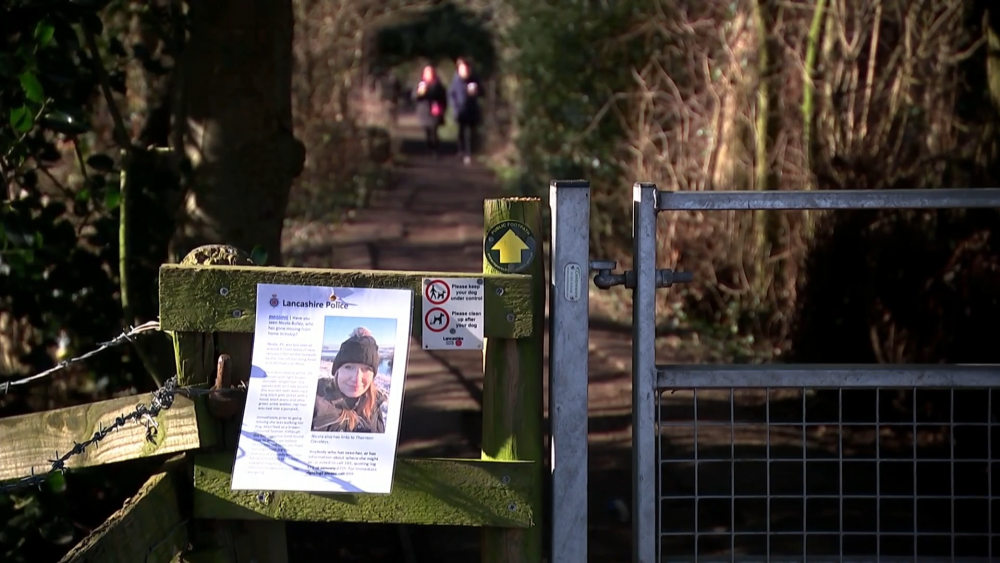Investigating The Disappearance: Clues, Evidence, And Solutions

Table of Contents
The Initial Phase: Securing the Scene and Gathering Clues
The initial hours and days following a reported disappearance are critical. Effective investigation of disappearances begins with a meticulous and swift response. Proper procedures in this crucial first phase can significantly impact the success of the overall investigation.
Immediate Actions:
The immediate actions taken at the potential scene of a disappearance are paramount. This involves a coordinated effort to preserve evidence and gather initial information.
- Secure the location: Preventing contamination of the scene is crucial. This involves establishing a perimeter, controlling access, and documenting the initial state of the area before any actions are taken. This is vital in preserving potential evidence, such as fingerprints, footprints, or other trace materials relevant to the missing person case.
- Interview witnesses immediately: Gathering firsthand accounts from anyone who may have seen or interacted with the missing person is essential. These early witness interviews can provide invaluable information about their last known whereabouts, behaviors, and any potential suspects. Detailed notes and recordings should be made of these initial interviews.
- Document the scene thoroughly: Comprehensive documentation is key. This includes detailed photographs, videos, and sketches of the scene, including any potential points of entry or exit. The use of 360-degree cameras can be especially beneficial in creating a comprehensive visual record.
- Identify potential points of entry and exit: Understanding how the individual may have left the scene is essential. Looking for signs of forced entry, unusual tracks, or disturbed areas can yield significant clues.
- Collect any personal belongings left behind: Any items belonging to the missing person can provide crucial leads. These should be carefully collected, documented, and processed for forensic analysis to detect potential fingerprints, DNA, or other relevant trace evidence.
Initial Information Gathering:
Parallel to securing the scene, gathering preliminary information about the missing person is crucial. This forms the foundation for developing investigative strategies.
- Detailed description: Accurate and complete physical descriptions (height, weight, hair color, eye color, clothing, distinctive marks, tattoos) are vital for creating accurate missing person posters and alerts.
- Contact information: Gathering contact details from family, friends, and colleagues provides valuable communication channels and potential leads. Building a comprehensive network of contacts allows for efficient information gathering and collaboration.
- Social media activity and digital footprints: Reviewing social media activity and online presence can offer crucial insights into the missing person's routines, contacts, and potential plans. Access to digital devices (with appropriate legal authorization) is important to obtain potential evidence from communications and location data.
- Routine and potential whereabouts: Understanding the missing person's daily routine, frequent locations, and social connections helps investigators focus their search efforts. This helps to narrow down the potential areas where the investigation should focus.
- Timeline of events: Establishing a precise timeline of events leading up to the disappearance is essential for identifying any inconsistencies or suspicious activities. This involves contacting family, friends, employers, and anyone who had recent contact with the missing individual.
Evidence Collection and Analysis: Uncovering the Truth
The success of any disappearance investigation hinges on the effective collection and analysis of evidence. This requires a multidisciplinary approach, combining various forensic techniques and investigative strategies.
Types of Evidence:
Several types of evidence can be crucial in solving disappearance cases. Investigators must be diligent in their search for and analysis of this evidence.
- Physical evidence: This includes fingerprints, DNA, hair fibers, clothing fibers, bodily fluids, weapons, or any trace evidence left at the scene or on the missing person.
- Digital evidence: This encompasses computer data, phone records, GPS data, social media activity, and emails, which can provide details on the missing person’s movements, communications, and digital interactions before their disappearance.
- Testimonial evidence: Witness statements and interviews play a crucial role. Investigators need to carefully collect and assess all eyewitness accounts, verifying their credibility and corroborating information.
- Circumstantial evidence: This includes any facts and circumstances that surround the disappearance, such as unusual events, timelines, patterns of behavior, financial records or any suspicious transactions.
Forensic Techniques:
Modern forensic science plays a pivotal role in analyzing evidence gathered during the investigation. Advanced techniques aid in identifying and linking suspects to the disappearance.
- DNA analysis and profiling: DNA evidence can link suspects to the crime scene or identify the remains of the missing person.
- Fingerprint analysis and comparison: Fingerprints found at the scene can identify individuals who may have been present.
- Digital forensics and data recovery: Digital forensics techniques are used to analyze computers, phones, and other digital devices to recover deleted data, track online activity and identify potential suspects.
- Trace evidence analysis: Analysis of hair, fibers, soil, or other trace materials can link a suspect to the scene or the victim.
- Surveillance footage analysis: Reviewing CCTV footage and other surveillance recordings from the area can provide valuable clues about the movements of the missing person or potential suspects.
Investigative Strategies and Solutions: Bringing Closure
Solving disappearance cases often requires a comprehensive and adaptable approach, utilizing a range of investigative strategies and technologies.
Investigative Approaches:
Several methods are employed in investigating disappearances. These methods often involve a collaborative effort between various law enforcement agencies and experts.
- Witness interviews and statements: Thorough and effective interviewing techniques are essential to gather accurate and reliable information from witnesses. This involves using specialized interviewing techniques and verifying information from multiple sources.
- Geographic profiling: This technique uses statistical analysis to identify areas where a suspect may be most likely to operate, based on their known movements and the location of crime scenes.
- Background checks on suspects: Thorough background checks are conducted to uncover any previous criminal history, associations, and potential motives.
- Collaboration with agencies and experts: Successful investigations often involve collaboration with local, state, and federal agencies, as well as forensic experts and specialized investigators.
- Advanced technologies: Advanced technologies such as facial recognition software and DNA databases can aid in identifying suspects and locating missing persons.
Finding Solutions and Bringing Closure:
Bringing closure to families affected by disappearances is paramount. This necessitates a holistic approach that extends beyond the investigation itself.
- Support and resources for families: Providing emotional and practical support to families of missing persons is essential during this extremely stressful time. This can involve access to counseling services, victim advocates, and community support groups.
- Media outreach and public awareness: Engaging the media and the public through press releases, social media campaigns, and public awareness efforts can help generate leads and raise awareness of the case.
- Community involvement: Encouraging community involvement in the investigation can lead to valuable tips and information from neighbors, friends, and other community members who may have seen or heard something relevant to the case.
- Highlighting successful strategies: Sharing successful strategies and best practices in solving disappearance cases helps to improve investigation techniques and outcomes.
- Legal and judicial processes: Understanding and navigating the legal and judicial processes involved in bringing closure is crucial, ensuring justice is served when possible.
Conclusion
Successfully investigating disappearances requires a multi-faceted approach, combining diligent evidence gathering, sophisticated forensic techniques, and effective investigative strategies. From securing the initial scene and gathering clues to analyzing evidence and pursuing leads, each step plays a critical role in finding solutions and bringing closure to families affected by these devastating events. By understanding the intricacies of investigating disappearances, and by utilizing a collaborative approach, we can increase the chances of finding missing persons and ensuring justice is served. Continue to learn more about effective methods for investigating disappearances, and contribute to the fight against unsolved cases. Understanding the complexities of investigating disappearances is a crucial step towards bringing closure to families and holding those responsible accountable.

Featured Posts
-
 Nvidias Rtx 5060 Debacle Exposes Issues In Gpu Reviews
May 25, 2025
Nvidias Rtx 5060 Debacle Exposes Issues In Gpu Reviews
May 25, 2025 -
 Volunteers Urgently Needed Annual Myrtle Beach Cleanup
May 25, 2025
Volunteers Urgently Needed Annual Myrtle Beach Cleanup
May 25, 2025 -
 Nippon Steels Us Acquisition Trump Administrations Green Light
May 25, 2025
Nippon Steels Us Acquisition Trump Administrations Green Light
May 25, 2025 -
 Kak Politicheskaya Satira Garazha Perezhila Plenum Blagodarya Brezhnevu
May 25, 2025
Kak Politicheskaya Satira Garazha Perezhila Plenum Blagodarya Brezhnevu
May 25, 2025 -
 Marktdraai Europese Aandelen Een Vergelijking Met Wall Street En Toekomstverwachtingen
May 25, 2025
Marktdraai Europese Aandelen Een Vergelijking Met Wall Street En Toekomstverwachtingen
May 25, 2025
Latest Posts
-
 The Ultimate Guide To Nike Running Shoes For 2025
May 26, 2025
The Ultimate Guide To Nike Running Shoes For 2025
May 26, 2025 -
 Moto Gp Inggris Sprint Race Trans7 Live Streaming Rekor Rins Jatuhnya Marquez
May 26, 2025
Moto Gp Inggris Sprint Race Trans7 Live Streaming Rekor Rins Jatuhnya Marquez
May 26, 2025 -
 Nikes Best Running Shoes For 2025 Style Performance And Comfort
May 26, 2025
Nikes Best Running Shoes For 2025 Style Performance And Comfort
May 26, 2025 -
 Jadwal Tayang Sprint Race Moto Gp Inggris Malam Ini Di Trans7 Rins Vs Marquez
May 26, 2025
Jadwal Tayang Sprint Race Moto Gp Inggris Malam Ini Di Trans7 Rins Vs Marquez
May 26, 2025 -
 2025s Best Nike Running Shoes A Buyers Guide
May 26, 2025
2025s Best Nike Running Shoes A Buyers Guide
May 26, 2025
